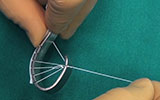ALERT!
This site is not optimized for Internet Explorer 8 (or older).
Please upgrade to a newer version of Internet Explorer or use an alternate browser such as Chrome or Firefox.
Anterior Leaflet Mitral Repair Using the Chordae System Technique Through Minimal Access
 UPDATE: A follow-up video has been added that demonstrates how to manufacture the chordae system.
UPDATE: A follow-up video has been added that demonstrates how to manufacture the chordae system.
The AHA/ACC guidelines for treatment of valvular heart disease state that mitral valve repair is the treatment of choice for patients with symptomatic severe MR. However, it is unfortunate that in USA and Europe the valve is repaired in only 50% of cases. Current techniques (valve resection/PTFE sutures) are effective in the treatment of posterior leaflet prolapse, but applying those techniques to repair anterior or bileaflet prolapse is technically more complex and requires a high level of skill and often leads to mitral valve replacement by surgeons who are unable to perform the full range of repair techniques.
With the aim of simplifying mitral repair, we propose a specially designed set of artificial chordae.
 The chordae system technique is an echocardiographically pre-measured array of PTFE chordae, manufactured by hand during chest opening and placement on cardiopulmonary bypass.
The chordae system technique is an echocardiographically pre-measured array of PTFE chordae, manufactured by hand during chest opening and placement on cardiopulmonary bypass.
The surgical technique then becomes very simple, avoiding complex measurements or leaflet resection. The surgeon only needs to determine the following factors: the middle of the prolapsed free edge of A2, and the fibro-tendinous tip of each papillary muscles (MAPP triad). The chordae system is then attached to the prolapsed free edge and anchored to the corresponding tip of the papillary muscle by only one stitch. It homogenously aligns the prolapsed edge to an ideal distance from papillary muscular plane, thus evenly equilibrating the systolic stress all along the strip of the device attached to the edge of the leaflet, with a potential advantageous role in terms of longevity.
The case report we present, concerns a 21 year-old male patient with a huge anterior leaflet prolapse without chordae rupture. Through a port-access incision, we implanted an echocardiographically pre-measured chordae system that was 29 mm long, to suspend the whole of the prolapsed leaflet back to its normal coaptation level. A 36 mm annuloplastic mitral ring was implanted to treat the annulus dilatation.
This technique is simple, fast, and reproducible, requiring no valve resection nor complicate measurements. Although a long-term follow up is necessary, we believe the chordae system technique is a good surgical option.
Disclosure:
Dr Marcio Scorsin, MD, PhD: I have a patent deposited in June 2006 concerning this technique. I have not, though, any commercial agreements of any kind with any commercial entity.
Video:
Manufacturing the Chordae System:



